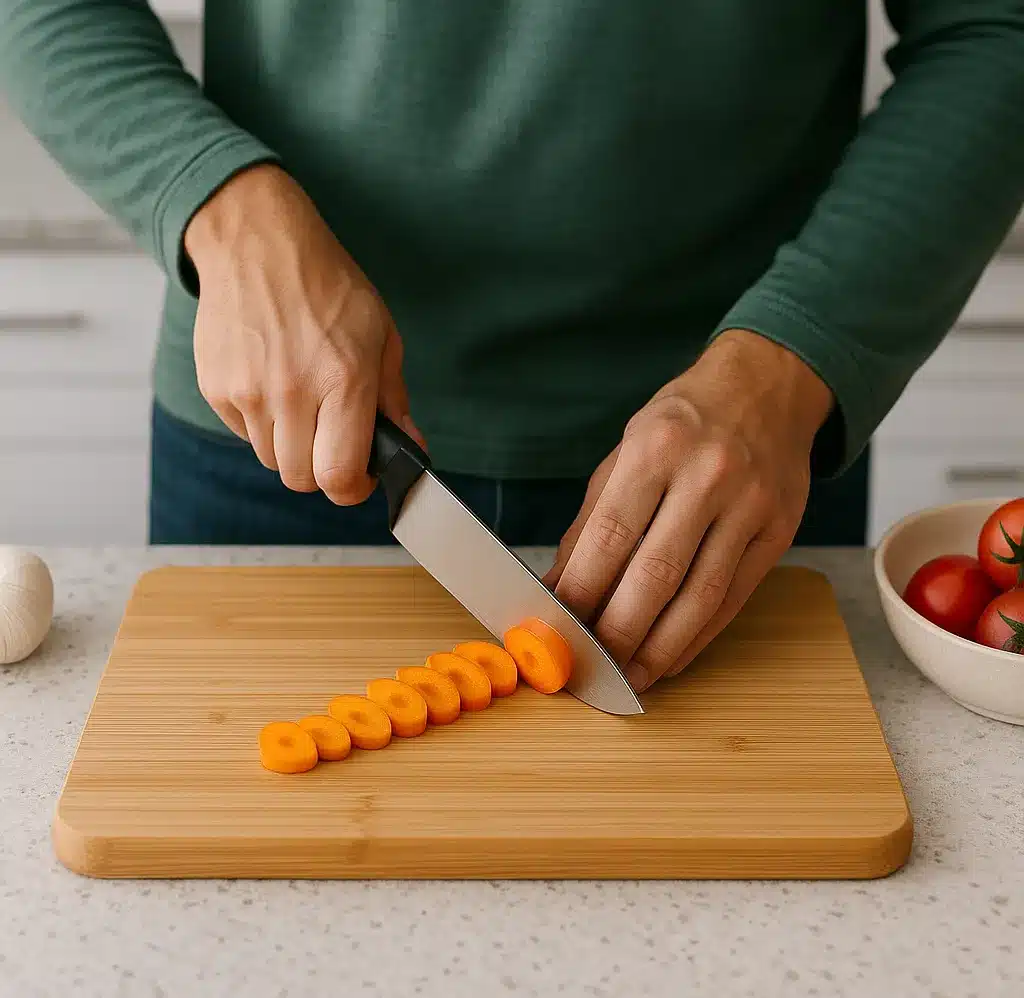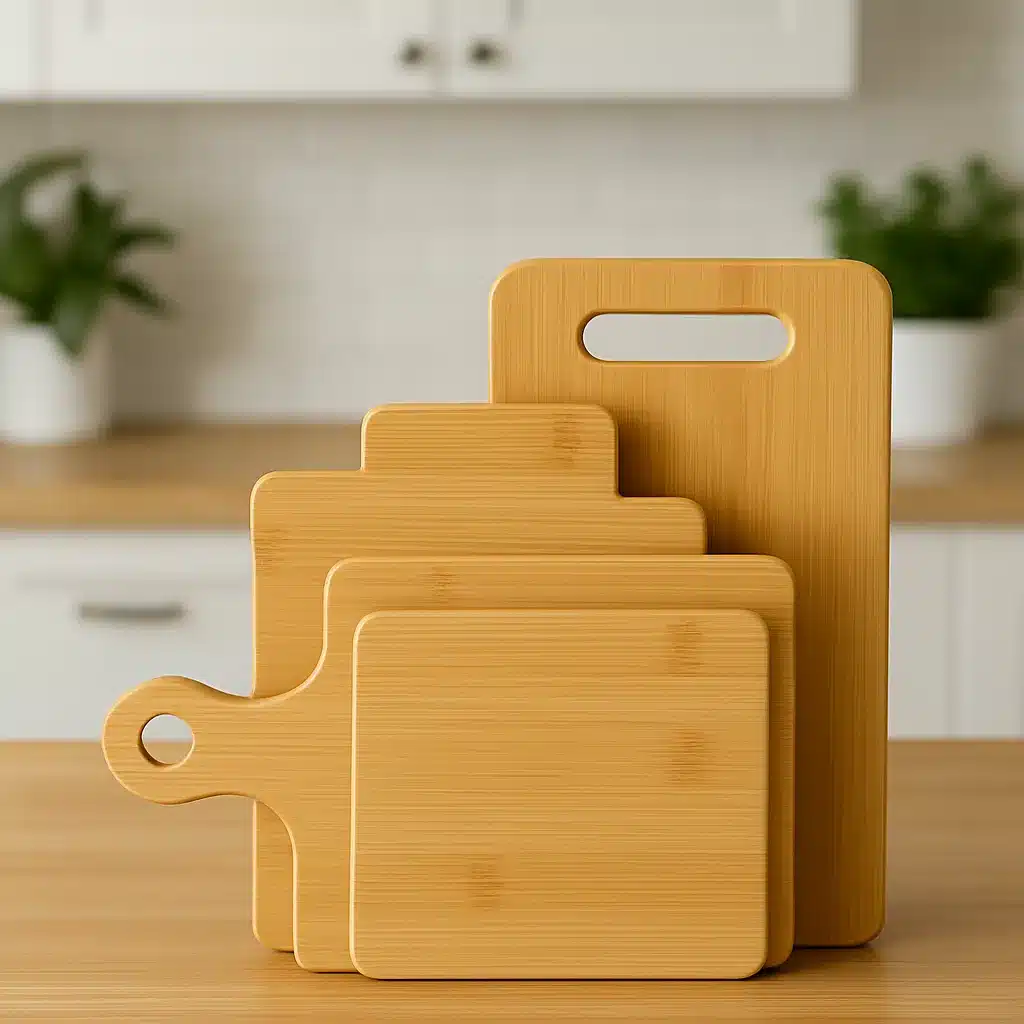Finding the right cutting board sounds simple, but if you’ve ever struggled with boards that crack, warp, or slide around while you’re chopping, you know it’s not always that easy. I’ve had my fair share of wobbly boards that made meal prep more stressful than it needed to be.
That’s where bamboo cutting boards come in. They’ve become a go-to in many kitchens, thanks to their practical benefits and eco-friendly appeal. And if you’re wondering about sustainability, every product I recommend here is Climate Pledge Friendly on Amazon.com, so you can feel good about your choice from the start.
Stick with me, and I’ll walk you through the top bamboo cutting board benefits, explain the pros and cons, and give you simple care tips to help yours last longer.
Table of Contents
What Makes Bamboo Different?
Bamboo might look and feel like wood, but did you know it’s actually a fast-growing grass? One of the biggest benefits of using a bamboo cutting board is that bamboo grows quickly, doesn’t need pesticides, and is fully biodegradable when its time is up. That makes it a renewable and eco-friendly choice for your kitchen.
But don’t let “grass” fool you—it’s tough stuff. Bamboo boards are dense and hard, so they can handle all kinds of chopping, whether you’re slicing veggies for soup or prepping your favorite snack. They’re also lighter than most hardwood boards, so they’re easy to move around or store when you’re done cooking.
Why So Many People Love Bamboo Boards
Here are some of the most talked-about bamboo cutting board benefits:
- Better for the planet – Bamboo grows fast without harsh chemicals, making it one of the most eco-friendly and non-toxic cutting board materials out there.
- Strong and durable – Resists knife marks, cracks, and warping when you care for it right.
- Lightweight but steady – Easy to handle, but won’t slide around too much on the counter.
- Less odor and stain buildup – Bamboo absorbs less moisture than many woods, but it’s still more porous than plastic, so you’ll want to clean it well after each use.
- Looks great – Its natural, golden tone makes it just as good for serving snacks as it is for prepping meals.
What You Should Know Before Buying One
Let’s look at some bamboo cutting board pros and cons to help you decide if it’s the right fit for your kitchen.
- They’re a bit hard on knives – Bamboo is harder than plastic and most woods, but it’s not as harsh as glass or stone. Still, you might need to sharpen your knives a little more often compared to using softer wood boards like maple.
- No dishwasher, please – Hot water and steam can damage bamboo. Always wash it by hand and dry it right away. Trust me, your board will thank you for keeping it out of the dishwasher.
- It needs regular treatment – A little bamboo cutting board treatment with food-grade mineral oil helps keep it from drying out or cracking. You can also try natural blends with beeswax or tung oil if you prefer an eco-friendlier finish.
- It can be brittle over time – While bamboo resists warping, cheaper or laminated boards can develop splinters or cracks if you skip the care routine.
- Not all boards are created equal – Cheap boards might use glues or finishes that aren’t food-safe, so always check before buying.
- Lifespan varies – With proper care, a bamboo cutting board can last several years. Budget boards might last 1–3 years, while higher-quality boards can go 5–10 years or more.

How to Make Your Bamboo Board Last
Follow these bamboo cutting board care tips to get the most life out of your board:
- Wash by hand with mild soap and warm water.
- Dry standing up so air can circulate and moisture doesn’t get trapped.
- Oil once a month (or when it looks dry) with bamboo cutting board oil or food-safe mineral oil. Natural oil blends with beeswax are another good option.
- Tackle stains or odors with lemon juice or baking soda.
- Use separate boards for raw meat to avoid cross-contamination, just like you would with any other board. Learn more about safe cutting board practices from the USDA here.
Bamboo vs. Plastic or Wood – What’s Better?
Wondering how bamboo compares to other cutting boards? Here’s a quick breakdown of the pros and cons of bamboo cutting boards compared to plastic and wood:
| Feature | Bamboo | Plastic | Wood |
|---|---|---|---|
| Eco-Friendliness | Renewable, biodegradable | Not biodegradable | Depends on the wood source |
| Durability | Tough, resists warping | Scars easily, needs replacing | Durable, but can crack if neglected |
| Knife-Friendliness | Can dull blades faster | Gentle on knives | Gentler than bamboo |
| Care | Hand-wash, needs oiling | Dishwasher safe, no oiling | Hand-wash, needs oiling |
| Looks | Simple, uniform color | Basic, functional look | Rich, varied grain patterns |
| Price | Affordable | Very affordable | Usually more expensive |
Frequently Asked Questions About Bamboo Cutting Boards
- Are there any downsides to bamboo cutting boards? Bamboo boards have a lot going for them, but they aren’t perfect. They can be a little rough on knives; they need oiling to keep them from drying out, and if you skip the care, they might crack or splinter over time. And no, these boards don’t belong in the dishwasher.
- Are bamboo cutting boards safe for raw meat? Yes, they’re safe—as long as you wash them well afterward. Like any cutting board, it’s smart to use one just for raw meat to avoid mixing up flavors or bacteria with your veggies. Clean it right away and dry it upright.
- How long do bamboo cutting boards last? It depends on the board and how you care for it. A cheaper one might last a year or two. A good one that you oil regularly could last five years or more. Take care of it, and you’ll get plenty of use out of it.
- Is it safe to wash bamboo cutting boards in the dishwasher? Nope, definitely not—trust me, your board will thank you for keeping it out of the dishwasher. Bamboo boards don’t like heat or steam. The dishwasher can make them crack, warp, or split. Always wash by hand with warm, soapy water, then dry it standing up. It’ll last much longer that way.
- Should I oil a bamboo cutting board? Yes, absolutely. Oiling your board keeps it from drying out or cracking. It’s really easy to do—just rub in some food-safe mineral oil every few weeks. If you’re into natural products, blends with beeswax or tung oil work great too.
- What kind of oil should you use on bamboo cutting boards? Most people go with food-grade mineral oil because it’s safe, cheap, and works well. But if you’d rather use something more natural, try an oil blend with beeswax or tung oil. Just avoid cooking oils—they can go bad and start to smell.
- How do you disinfect a bamboo cutting board so you don’t get bacteria? First, wash your board with soap and warm water. Want to give it a deeper clean? Grab some white vinegar or sprinkle on a little baking soda or lemon juice. Scrub it in, rinse well, and let it dry standing up so air can reach all sides. It’s quick, easy, and keeps your board fresh for next time.
Final Thoughts on Bamboo Cutting Board Benefits
So, do you think a bamboo cutting board is worth it? If you ask me, absolutely. It checks all the boxes: eco-friendly, durable, and easy to care for. Sure, it needs a little oiling now and then, but it gives back plenty in return. The bamboo cutting board benefits I’ve covered here really do make it an easy choice if you’re looking for something practical that looks good in your kitchen too. Now that you know the bamboo cutting board benefits—and a few drawbacks to watch for—you can decide if it feels right for your kitchen.
No matter what size you choose—whether it’s a large bamboo cutting board for meal prep or a smaller one for snacks—you’ll get something practical that feels good to use every day.
And here’s one more thing to feel good about—all the products I write about, including every bamboo cutting board I feature, are Climate Pledge Friendly on Amazon.com. This means they meet recognized sustainability standards, helping you make choices that are better for your kitchen and a small step toward reducing waste.
Wondering how bamboo stacks up against other materials? Check out my full bamboo vs acacia cutting board comparison to see how they differ in durability, care, and kitchen use.
If bamboo feels like the right fit for your kitchen, check out my review of the best bamboo cutting board sets to find practical, affordable options for everyday use.

